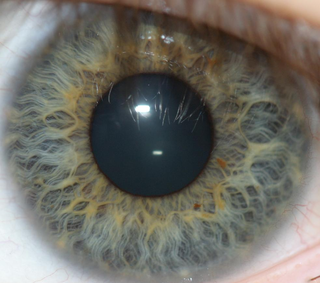
Authentication is the act of proving an assertion, such as the identity of a computer system user. In contrast with identification, the act of indicating a person or thing's identity, authentication is the process of verifying that identity. It might involve validating personal identity documents, verifying the authenticity of a website with a digital certificate, determining the age of an artifact by carbon dating, or ensuring that a product or document is not counterfeit.
Biometrics are body measurements and calculations related to human characteristics. Biometric authentication is used in computer science as a form of identification and access control. It is also used to identify individuals in groups that are under surveillance.

Iris recognition is an automated method of biometric identification that uses mathematical pattern-recognition techniques on video images of one or both of the irises of an individual's eyes, whose complex patterns are unique, stable, and can be seen from some distance. The discriminating powers of all biometric technologies depend on the amount of entropy they are able to encode and use in matching. Iris recognition is exceptional in this regard, enabling the avoidance of "collisions" even in cross-comparisons across massive populations. Its major limitation is that image acquisition from distances greater than a meter or two, or without cooperation, can be very difficult. However, the technology is in development and iris recognition can be accomplished from even up to 10 meters away or in a live camera feed.

A facial recognition system is a technology potentially capable of matching a human face from a digital image or a video frame against a database of faces. Such a system is typically employed to authenticate users through ID verification services, and works by pinpointing and measuring facial features from a given image.
Data security means protecting digital data, such as those in a database, from destructive forces and from the unwanted actions of unauthorized users, such as a cyberattack or a data breach.
Living in the intersection of cryptography and psychology, password psychology is the study of what makes passwords or cryptographic keys easy to remember or guess.
Private biometrics is a form of encrypted biometrics, also called privacy-preserving biometric authentication methods, in which the biometric payload is a one-way, homomorphically encrypted feature vector that is 0.05% the size of the original biometric template and can be searched with full accuracy, speed and privacy. The feature vector's homomorphic encryption allows search and match to be conducted in polynomial time on an encrypted dataset and the search result is returned as an encrypted match. One or more computing devices may use an encrypted feature vector to verify an individual person or identify an individual in a datastore without storing, sending or receiving plaintext biometric data within or between computing devices or any other entity. The purpose of private biometrics is to allow a person to be identified or authenticated while guaranteeing individual privacy and fundamental human rights by only operating on biometric data in the encrypted space. Some private biometrics including fingerprint authentication methods, face authentication methods, and identity-matching algorithms according to bodily features. Private biometrics are constantly evolving based on the changing nature of privacy needs, identity theft, and biotechnology.
Multi-factor authentication is an electronic authentication method in which a user is granted access to a website or application only after successfully presenting two or more pieces of evidence to an authentication mechanism. MFA protects personal data—which may include personal identification or financial assets—from being accessed by an unauthorized third party that may have been able to discover, for example, a single password.

Vein matching, also called vascular technology, is a technique of biometric identification through the analysis of the patterns of blood vessels visible from the surface of the skin. Though used by the Federal Bureau of Investigation and the Central Intelligence Agency, this method of identification is still in development and has not yet been universally adopted by crime labs as it is not considered as reliable as more established techniques, such as fingerprinting. However, it can be used in conjunction with existing forensic data in support of a conclusion.
IDEX Biometrics ASA is a Norwegian biometrics company, specialising in fingerprint imaging and fingerprint recognition technology. The company was founded in 1996 and is headquartered in Oslo, but its main operation is in the US, with offices in New York and Massachusetts. The company also has offices in the UK and China.
A whole new range of techniques has been developed to identify people since the 1960s from the measurement and analysis of parts of their bodies to DNA profiles. Forms of identification are used to ensure that citizens are eligible for rights to benefits and to vote without fear of impersonation while private individuals have used seals and signatures for centuries to lay claim to real and personal estate. Generally, the amount of proof of identity that is required to gain access to something is proportionate to the value of what is being sought. It is estimated that only 4% of online transactions use methods other than simple passwords. Security of systems resources generally follows a three-step process of identification, authentication and authorization. Today, a high level of trust is as critical to eCommerce transactions as it is to traditional face-to-face transactions.

The Ghana Card is the national Identity card that is issued by the Ghanaian authorities to Ghanaian citizens – both resident and non-resident, legal and permanent residents of foreign nationals. It is proof of identity, citizenship and residence of the holder. The current version is in ID1 format and biometric. It is issued by the National Identification Authority of Ghana and Regarded as a property of the country as such. In July 2023, through the initiative of the Vice President, Dr. Mahamudu Bawumia, new card numbers were issued to newborn babies as part of pilot program to incorporate newborn babies unto the database.

A smudge attack is an information extraction attack that discerns the password input of a touchscreen device such as a cell phone or tablet computer from fingerprint smudges. A team of researchers at the University of Pennsylvania were the first to investigate this type of attack in 2010. An attack occurs when an unauthorized user is in possession or is nearby the device of interest. The attacker relies on detecting the oily smudges produced and left behind by the user's fingers to find the pattern or code needed to access the device and its contents. Simple cameras, lights, fingerprint powder, and image processing software can be used to capture the fingerprint deposits created when the user unlocks their device. Under proper lighting and camera settings, the finger smudges can be easily detected, and the heaviest smudges can be used to infer the most frequent input swipes or taps from the user.
Biometrics refers to the automated recognition of individuals based on their biological and behavioral characteristics, not to be confused with statistical biometrics; which is used to analyse data in the biological sciences. Biometrics for the purposes of identification may involve DNA matching, facial recognition, fingerprints, retina and iris scanning, voice analysis, handwriting, gait, and even body odor.

Touch ID is an electronic fingerprint recognition feature designed and released by Apple Inc. that allows users to unlock devices, make purchases in the various Apple digital media stores, and authenticate Apple Pay online or in apps. It can also be used to lock and unlock password-protected notes on iPhone and iPad. Touch ID was first introduced in iPhones with 2013's iPhone 5s, In 2015, Apple introduced a faster second-generation Touch ID in the iPhone 6s; a year later in 2016, it made its laptop debut in the MacBook Pro integrated on the right side of the Touch Bar. Touch ID has been used on all iPads since the iPad Air 2 was introduced in 2014. In MacBooks, each user account can have up to three fingerprints, and a total of five fingerprints across the system. Fingerprint information is stored locally in a secure enclave on the Apple A7 and later chips, not in the cloud, a design choice intended to secure fingerprint information from users or malicious attackers.
Identity-based security is a type of security that focuses on access to digital information or services based on the authenticated identity of an entity. It ensures that the users and services of these digital resources are entitled to what they receive. The most common form of identity-based security involves the login of an account with a username and password. However, recent technology has evolved into fingerprinting or facial recognition.

A biometric device is a security identification and authentication device. Such devices use automated methods of verifying or recognising the identity of a living person based on a physiological or behavioral characteristic. These characteristics include fingerprints, facial images, iris and voice recognition.
DeepFace is a deep learning facial recognition system created by a research group at Facebook. It identifies human faces in digital images. The program employs a nine-layer neural network with over 120 million connection weights and was trained on four million images uploaded by Facebook users. The Facebook Research team has stated that the DeepFace method reaches an accuracy of 97.35% ± 0.25% on Labeled Faces in the Wild (LFW) data set where human beings have 97.53%. This means that DeepFace is sometimes more successful than human beings. As a result of growing societal concerns Meta announced that it plans to shut down Facebook facial recognition system, deleting the face scan data of more than one billion users. This change will represent one of the largest shifts in facial recognition usage in the technology's history. Facebook planned to delete by December 2021 more than one billion facial recognition templates, which are digital scans of facial features. However, it did not plan to eliminate DeepFace which is the software that powers the facial recognition system. The company has also not ruled out incorporating facial recognition technology into future products, according to Meta spokesperson.
Biometric tokenization is the process of substituting a stored biometric template with a non-sensitive equivalent, called a token, that lacks extrinsic or exploitable meaning or value. The process combines the biometrics with public-key cryptography to enable the use of a stored biometric template for secure or strong authentication to applications or other systems without presenting the template in its original, replicable form.

Face ID is a facial recognition system designed and developed by Apple Inc. for the iPhone and iPad Pro. The system allows biometric authentication for unlocking a device, making payments, accessing sensitive data, providing detailed facial expression tracking for Animoji, as well as six degrees of freedom (6DOF) head-tracking, eye-tracking, and other features. Initially released in November 2017 with the iPhone X, it has since been updated and introduced to several new iPhone models, and all iPad Pro models.















